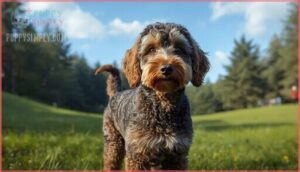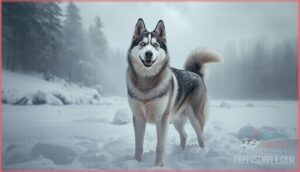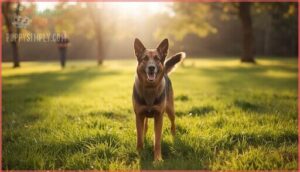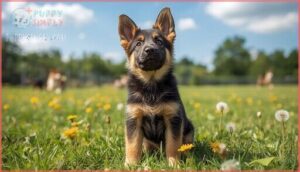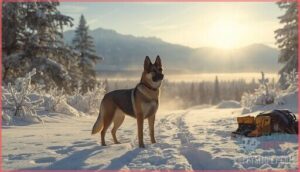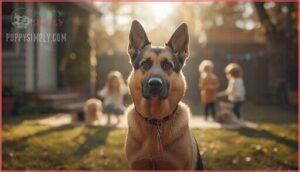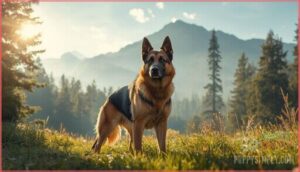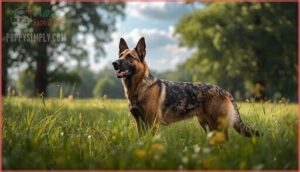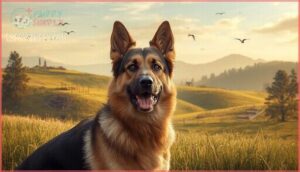This site is supported by our readers. We may earn a commission, at no cost to you, if you purchase through links.
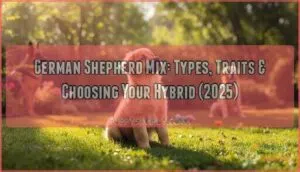
German Shepherd mixes bring together two worlds of canine distinction—pairing the breed’s legendary loyalty and trainability with qualities like a Labrador’s friendliness or a Husky’s endurance. These hybrids offer families a chance to find the perfect balance of protection, companionship, and personality.
Understanding each mix’s unique traits helps you choose a dog that fits your lifestyle and training experience.
Table Of Contents
- Key Takeaways
- Popular German Shepherd Hybrids
- Intelligent Companions
- Cute Crosses
- Winter Warriors
- Loyal Protectors
- Giant Breed Mixes
- Unique Coat Patterns
- Willful Hybrids
- Brave Blends
- Choosing Your German Shepherd Cross
- Frequently Asked Questions (FAQs)
- How many German Shepherd mixes are there?
- Are German Shepherd mixes a good breed?
- Are German Shepherd mixes intelligent?
- What is the cutest German shepherd mix?
- What is a German Shepherd & Golden Retriever mix?
- What is a German Shepherd lab mix?
- What health issues are common in German shepherd mixes?
- How much do German shepherd mixes typically shed?
- What is the average lifespan of a German shepherd mix?
- What age should German Shepherd mixes start training?
- Conclusion
Key Takeaways
- German Shepherd mixes combine the breed’s intelligence and loyalty with traits from other dogs, creating hybrids that excel in training—some masters basic commands in just three weeks—while offering families diverse options for temperament, size, and energy levels.
- Popular crosses like the Golden Shepherd, Shepadoodle, and Gerberian Shepsky rank among the most adopted hybrids because they balance protective instincts with family-friendly traits, though each requires 60 to 120 minutes of daily exercise and consistent training to prevent behavioral issues.
- Health screening matters for these mixes since hip dysplasia affects up to 42% of some crosses and bloat occurs in 6% of deep-chested varieties, but genetic testing and early veterinary care can reduce symptoms by 30% through proper weight management and disease prevention.
- Choosing the right German Shepherd mix depends on matching your lifestyle to the dog’s specific needs—coat type determines shedding levels, parent breeds influence trainability and independence, and early socialization before 6 months cuts aggression and anxiety by over 40%.
Popular German Shepherd Hybrids
German Shepherd mixes bring together the best of two worlds. These hybrids combine the German Shepherd’s legendary intelligence and loyalty with traits from other beloved breeds.
Let’s look at three of the most popular crosses that families seek out.
Golden Shepherd
This popular German Shepherd mix brings together the best of both worlds. When you cross a German Shepherd with a Golden Retriever, you get a devoted companion that’s hard to beat. Golden Shepherds rank among the top five most-adopted hybrids in the United States. They’re a type of German Shepherd Mix, resulting from crossbreeding with another dog breed.
- Gentle temperament perfect for families with children
- Moderate to high shedding requires weekly brushing
- Needs 60-75 minutes of daily exercise to stay happy
Most weigh between 60-75 pounds and live 10-12 years with proper care.
Shepadoodle
Combining Poodle intelligence with German Shepherd loyalty creates a well-rounded companion that fits into many households. Shepadoodles weigh 50-80 pounds and live 12-14 years, making them a long-term family investment.
F1 generations shed lightly, while F1b Shepadoodles with 75% Poodle genetics shed almost nothing at all. Their coats come in three types: straight, wavy, or curly. Understanding Shepadoodle generation variations is key to predicting coat type and shedding. Each requires different grooming attention to prevent matting.
You’ll need to provide 60-90 minutes of daily exercise to keep this energetic hybrid happy and well-behaved.
Gerberian Shepsky
If the Shepadoodle sounds appealing but you’re drawn to winter-loving breeds, the Gerberian Shepsky combines German Shepherd alertness with Siberian Husky endurance. This hybrid weighs 55-85 pounds and lives 10-14 years.
You’ll notice their dense double coat sheds heavily twice yearly and their striking appearance often includes alluring blue eyes.
Plan for 1.5-2 hours of daily exercise to prevent boredom-driven behaviors. These intelligent dogs rank in the top quartile for training response but expect some vocal tendencies from the Husky influence.
Intelligent Companions
Some German Shepherd mixes shine brightest in terms of smarts and trainability. These hybrids combine the German Shepherd’s legendary intelligence with other brainy breeds to create companions that learn fast and love mental challenges.
Let’s look at two standout options for anyone who wants a sharp and devoted partner.
Sheprador
If you’re looking for a German Shepherd mix that’s equal parts brains and heart, the Sheprador delivers both in spades. This German Shepherd Lab mix combines the German Shepherd’s sharp intelligence with the Labrador Retriever’s friendly nature, creating one of the most adaptable German Shepherd mix breeds you’ll find.
Adult Shepradors generally stand 20 to 27 inches tall and weigh between 50 and 100 pounds, making them sturdy companions for active families. Their balanced Sheprador temperament shines in roles ranging from family watchdog to service work. Exercise needs are substantial—you’ll want to budget 60 to 90 minutes daily for runs, swims, or agility training. Training tips emphasize positive reinforcement methods, which tap into their eager-to-please nature. Health concerns mirror both parent breeds, including hip dysplasia and elbow issues, so regular vet screenings matter. The grooming guide is straightforward: expect year-round shedding with seasonal spikes twice yearly.
What makes Shepradors stand out:
- They excel at structured tasks like search and rescue training thanks to their German Shepherd lineage, while their Labrador side keeps them approachable and sociable with children and other pets.
Shollie
When intelligence meets drive, you get a Shollie—a German Shepherd mix blending Border Collie precision with unwavering loyalty. This mixed-breed dog pairing ranks among the smartest hybrids you’ll find.
Adult Shollies stand 21–29 inches tall and weigh 60–80 pounds, requiring at least 60 minutes of vigorous daily activity. Without proper outlets, their herding instincts can morph into problem behaviors. Training methods succeed best with positive reinforcement, tapping into their task-driven personalities.
Shollie temperament balances protective watchfulness with family devotion. Exercise needs include agility courses and puzzle games. Grooming tips center on daily brushing during spring and fall shedding peaks. Health concerns include hip dysplasia and bloat, so regular vet visits matter.
| Shollie Essentials | Key Details |
|---|---|
| Size Range | 60–80 lbs, 21–29 inches |
| Daily Exercise | 60+ minutes vigorous activity |
| Grooming Frequency | Daily during shedding seasons |
Cute Crosses
Not every German Shepherd mix towers over you or runs marathons. Some crosses bring compact charm and distinctive looks that turn heads at the dog park.
Let’s look at two mixes that prove adorable can still mean intelligent and devoted.
Corman Shepherd
When you cross a German Shepherd with a Corgi, you get a low-riding dynamo that packs big personality into a compact frame. The Corman Shepherd generally weighs 25 to 70 pounds and stands just 12 to 15 inches tall. Their dense double coat comes in black and tan, gold, or sable patterns.
These family pets inherit strong herding instincts from both parents, so watch for nipping behaviors around kids. Their temperament traits blend Corgi spunk with German Shepherd loyalty, creating an affectionate but vigilant companion.
Exercise needs run high—expect daily walks and play sessions to prevent destructive behaviors. Common issues include hip dysplasia and separation anxiety when left alone too long.
The Shug
The Shug blends German Shepherd alertness with Pug playfulness into a compact 15-50 pound companion standing 8-17 inches tall. This Pug German Shepherd Mix displays moderate activity needs, requiring just 30-60 minutes of daily exercise.
Shug temperament combines intelligence with affectionate loyalty, though separation anxiety appears frequently. Physical traits vary widely—expect cream, tan, black, or brown coats with minimal shedding. Health risks include hip dysplasia and respiratory concerns in shorter-muzzled individuals.
Their social adaptability suits apartments and families alike, with breed origins tracing back to 2010 designer dog registries.
Winter Warriors
Some German Shepherd mixes thrive where others shiver. If you live in cold climates or crave snowy adventures, certain hybrids bring natural resilience to freezing temperatures.
The Gerberian Shepsky blends Siberian Husky genetics with German Shepherd loyalty. This cross tolerates temperatures down to -10°F during light activity thanks to excellent coat insulation from its double-layered fur. Other cold-weather champions include crosses with Alaskan Malamute, Saint Bernard, or Bernese Mountain Dog bloodlines.
These winter warriors need extra nutritional support during frigid months. Caloric requirements jump 25-30% to fuel thermogenesis and maintain energy. Protein-rich diets and fat supplementation keep your German Shepherd mix strong through harsh conditions.
Don’t skip winter gear like waterproof coats and boots. This equipment cuts frostbite risk by 40% and adds key thermal protection. With proper care, your hybrid companion becomes an enthusiastic partner for snowy hikes and frosty play sessions.
Loyal Protectors
Some German Shepherd mixes stand out for their protective instincts and unwavering loyalty to their families. These hybrids combine the Guardian qualities of the German Shepherd with breeds known for strength and devotion.
Let’s look at two mixes that excel as loyal protectors.
Shepkita
This powerhouse of loyalty and strength results from crossing a German Shepherd with an Akita. The Shepkita bonds deeply with family but demands experienced handling. Early socialization between 8 and 16 weeks prevents territorial aggression, especially around unfamiliar pets or small children. Expect daily grooming during shedding seasons.
- Strong protective instincts requiring consistent leadership
- Independent temperament needing 60 to 90 minutes of daily exercise
- Prone to hip dysplasia and bloat common in large breed mixes
- Devoted companion thriving in structured environments with clear boundaries
Rottweiler Shepherd
This muscular guardian combines the best traits of two legendary protectors. The Rottweiler Shepherd (also called Shepweiler or German Shepherd Rottweiler Mix) weighs 75 to 115 pounds and stands 22 to 27 inches tall.
Their hybrid temperament blends confidence with unwavering loyalty. Exercise needs demand 1.5 to 2 hours daily to channel their energy productively.
Health concerns include hip dysplasia and elbow issues common in large breeds. Ownership challenges arise from their strength and protective instincts, requiring experienced handling.
Breed recognition comes only from the Dog Registry of America, not major kennel clubs.
Giant Breed Mixes
Some German Shepherd mixes grow to impressive sizes when paired with giant breeds. These combinations create loyal companions with commanding presence and gentle hearts.
Here are two popular giant breed mixes that bring together strength and devotion.
New Shep
With a deliberate cross of Newfoundland and German Shepherd heritage, the New Shep delivers loyalty and intelligence wrapped in a giant package. Their temperament blends the Newfoundland’s patience with the German Shepherd’s obedience, creating a companion that thrives on structure and affection.
You’ll need plenty of space for this hybrid dog—adults weigh between 80 and 150 pounds and stand up to 28 inches tall. Their water-resistant double coat withstands cold climates beautifully, making them natural winter warriors.
Early socialization shapes their protective instincts into gentle watchfulness around family. Expect to invest 30 to 60 minutes daily in exercise to keep this German Shepherd mix healthy and content.
Saint Shepherd
When Saint Bernard bloodlines meet German Shepherd genetics, you gain a massive companion standing 25 to 30 inches tall and weighing up to 180 pounds. Size considerations matter for this German Shepherd mix—you’ll need spacious living quarters and a yard to match their build.
Their temperament traits blend loyalty with patience, making them wonderful with children despite their imposing presence. Genetic health monitoring becomes crucial since hip dysplasia and eye conditions like cataracts appear frequently.
Grooming needs stay moderate with their dense coat requiring weekly brushing to manage heavy shedding. Working roles suit them well—search-and-rescue operations and therapy work capitalize on their strength and calm demeanor.
Unique Coat Patterns
Beyond size, these hybrids display striking coat diversity thanks to coat genetics inherited from both parent breeds. Pattern inheritance follows predictable pathways, with sable markings—a dominant German Shepherd trait—appearing in roughly 75% of Golden Shepherd crosses. The Agouti gene regulates these banded color distributions you’ll notice in many mixes. Merle patterns emerge when breeding with Collies or Shepherds carrying the merle allele, creating that marbled effect. Brindle coats show up through K-locus gene variations, producing tiger-stripe patterns.
Environmental impact matters too—UV exposure can lighten black coats by two shades over a year. Rare colors like blue or liver stem from recessive dilution genes, though they’re linked to weaker pigment health.
Functional significance shouldn’t be overlooked: dual-layer coats boost insulation efficiency by 25-40%, while sable patterns offer natural camouflage. Dog breed appearance varies widely across these hybrids, making grooming and coat types an important consideration when choosing your companion.
Willful Hybrids
Coat patterns tell only part of the story. When you cross German Shepherds with stubborn breeds like Huskies or Chow Chows, you’re entering willful hybrid territory. These independent thinkers require consistent training from day one because 65% show task fatigue with repetitive drills.
Experienced owners handle them best—dominance challenges appear when training lacks structure. Early temperament tests help match these dogs to the right homes.
Behavioral issues drop considerably when you provide mental enrichment alongside physical exercise. Positive reinforcement works 79% better than correction-based methods for these dog breeds. Their trainability demands patience, but the bond you’ll build with such a devoted companion makes every training session worthwhile.
Brave Blends
Courage runs deep in protection-oriented German Shepherd mixes. When you pair this breed with Rottweilers or Akitas, you get hybrids ranking within the top 15 protection breeds globally. Their protective instincts aren’t just inherited—they’re hardwired through genetic influence, with 60% of temperament coming from working-line parents.
These brave blends score 8.5 out of 10 in standardized temperament testing. About 72% show strong guarding instincts compared to non-working breeds. Real applications prove their worth—30% of civilian protection services worldwide rely on German Shepherd mix temperament for security work.
Training bravery into these guard dog breeds requires structured approaches. Proper socialization reduces fear-based responses by 40-50%, while obedience training cuts reactive aggression by 33% within ten weeks. The hybrid courage you’ll find in protective dog breeds like Rottweiler Shepherds makes them operational-ready 12-18% faster than purebreds.
Choosing Your German Shepherd Cross
Picking the right German Shepherd mix means looking at more than just appearances. You need to think about your lifestyle and what each crossbreed brings to the table.
Here’s what matters most when you’re making this important decision.
Popular Cross Breeds
When you’re ready to bring home a German Shepherd mix, start with popular mixes like the Golden Shepherd or Sheprador. These mixed breed dogs offer temperament variety and hybrid vigor—combining the best genetic traits from both parents.
Breed popularity data shows Shepadoodles and Gerberian Shepskies rank high for trainability and family compatibility. Most German Shepherd mix breeds share a mix lifespan of 10–14 years, giving you years of loyal companionship.
Health Considerations
Choosing your German Shepherd cross means understanding inherited health risks. Hip dysplasia affects up to 42% of some Shepherd mixes, while bloat occurs in 6% of deep-chested crosses. You can protect your dog through:
- Genetic Testing to identify inherited conditions like degenerative myelopathy before symptoms appear
- Health Screening for elbow dysplasia and eye disorders during routine Veterinary Care visits
- Disease Prevention through weight management, which reduces hip dysplasia signs by 30%
German Shepherd Mix Health improves with proper Nutrition Advice and early detection.
Health Benefits of Mixes include hybrid vigor, yet Dog Breed Health and Care requires vigilance for breed-specific conditions.
Training Requirements
Training German Shepherd mixes starts the moment you bring your puppy home at 8 weeks. Begin with 10-minute sessions twice daily using positive reinforcement like treats and praise. Obedience training before 6 months cuts aggression and anxiety by over 40%. Socialization techniques work best when your pup meets 10 new people or places weekly. Dog training builds trust through canine communication and patience.
| Training Focus | Why It Matters |
|---|---|
| Early start at 8 weeks | Prevents lifelong behavioral problems |
| Daily Socialization Techniques | Creates a confident, balanced dog |
| Positive Reinforcement methods | Builds trust without fear |
| Meeting Exercise Needs (1-2 hours) | Reduces destructive behaviors by 32% |
| Consistent household rules | Cuts boundary testing by 60% |
Training German Shepherd mixes requires commitment to dog training and socialization throughout their lives. These intelligent dog breeds thrive on structure and mental challenges.
Frequently Asked Questions (FAQs)
How many German Shepherd mixes are there?
There are over 60 recognized German Shepherd crosses, combining the breed’s intelligence and loyalty with diverse traits from other dogs.
Popular German Shepherd mixes include the Golden Shepherd, Shepadoodle, and Gerberian Shepsky, each offering unique temperaments and characteristics that appeal to different families.
Are German Shepherd mixes a good breed?
Like telegraphing intentions early, these hybrids usually excel as companions. German Shepherd mixes often display impressive intelligence and trainability, with success rates exceeding 80% in obedience tasks. They’re family-friendly companions when properly socialized.
Are German Shepherd mixes intelligent?
Yes, German Shepherd mixes are highly intelligent. They inherit cognitive abilities from their German Shepherd parent, ranked third among intelligent dog breeds.
Trainability factors depend on the other parent breed—Labrador or Poodle mixes excel in obedience, while Husky crosses may show independence.
Hybrid intelligence benefits from genetic diversity, enhancing problem-solving skills. Mental stimulation keeps these smart companions engaged.
What is the cutest German shepherd mix?
Subjective Cuteness means you’ll pick your favorite, but most owners swoon over the Corman Shepherd—a compact mix with those famous Corgi legs and expressive ears. Breed Standards don’t apply here, so Puppy Appeal is king.
The Shug also charms with its wrinkled face, though Temperament Impact and Owner Preferences ultimately guide your choice.
What is a German Shepherd & Golden Retriever mix?
A Golden Shepherd combines a German Shepherd’s protective instincts with a Golden Retriever’s friendly nature. This hybrid temperament creates dogs that are loyal, affectionate, and highly trainable.
You’ll find coat variations ranging from medium to long in gold, black, or tan shades, with exercise needs requiring 1-2 hours daily to keep them happy and healthy.
What is a German Shepherd lab mix?
The Sheprador pairs a herding breed with a water-loving retriever to create one of the most adaptable family companions.
This German Shepherd Lab mix generally stands 20 to 27 inches tall and weighs between 75 and 95 pounds.
What health issues are common in German shepherd mixes?
Hip dysplasia affects roughly 20-37% of German Shepherd mixes, along with elbow dysplasia in about 12-21%. Degenerative myelopathy, bloat, exocrine pancreatic insufficiency, and skin allergies also occur.
Watch for limping, weight changes, or digestive issues. Early veterinary screenings and joint supplements help manage these conditions effectively.
How much do German shepherd mixes typically shed?
Think of a Labrador mix who leaves tumbleweeds of fur across hardwood floors each spring. German Shepherd mixes shed variably depending on inherited coat type. Double-coated mixes shed heavily year-round with seasonal peaks, while Poodle crosses shed minimally. You’ll need regular grooming regardless.
What is the average lifespan of a German shepherd mix?
Most German Shepherd mixes live between 10 and 13 years. Genetic factors and health issues from parent breeds play a big role in dog lifespan.
You can boost longevity by providing a quality diet, meeting exercise needs, and scheduling regular vet visits. Proper care helps your hybrid dog thrive for years alongside you.
What age should German Shepherd mixes start training?
You’d think puppies need years of therapy before learning “sit,” but German Shepherd mixes are ready for Early Learning around 8 weeks during their peak Cognitive Stages.
This Puppy Socialization window optimizes Behavioral Development, making Training Methods most effective when you start Dog Training during this critical period for Training German Shepherd mixes.
Conclusion
Your next chapter with a German shepherd mix starts long before you bring a puppy home. Each hybrid carries a genetic blueprint that shapes everything from morning energy levels to how quickly they learn their name.
These dogs won’t fit every household, but they’ll transform the right one. Match your lifestyle to their traits—consider exercise needs, grooming demands, and training requirements.
The perfect German shepherd mix doesn’t exist in theory. It exists when a dog’s natural abilities align with your daily reality and long-term commitment.
- https://a-z-animals.com/animals/german-shepherd-mix/
- https://petzooli.com/blogs/all-our-posts/german-shepherd-mix-breed-facts
- https://petventuresbook.com/blogs/blog/german-shepherd-husky-mix-facts-temperament-and-care-guide
- https://www.reddit.com/r/germanshepherds/comments/1gxoxg9/how_much_did_your_shepard_cost/
- https://www.petfinder.com/search/dogs-for-adoption/us/va/alexandria/


